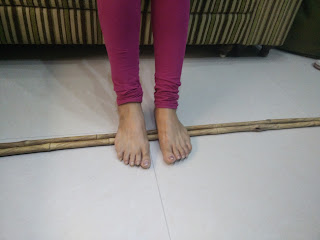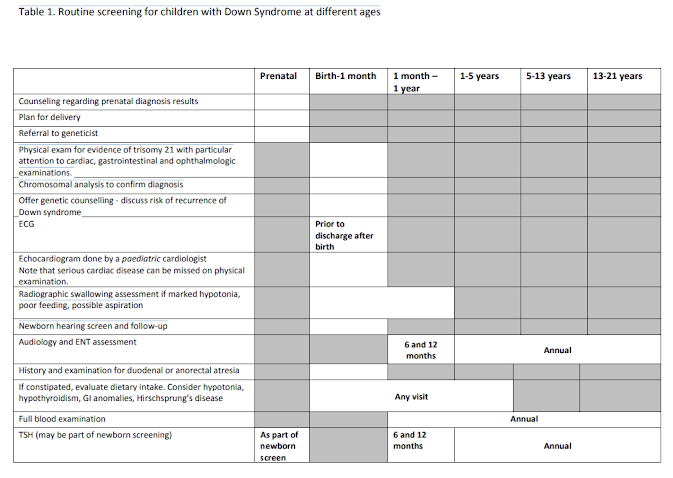FLAT FOOT & THE CHILD WITH DS
Before coming to the actual topic let me share that all the techniques shown are actually done with my daughter Palak who is now 23. Some of the images shown are internet images for the purpose of either clarity or unavailability of my own pictures.
My blogs are full of activities. The reason is, to me these are the actual things you need to do with your kids. We did it and the result is our daughter Palak. There is nothing she haven't done or she can't do.
Young parents are very ambitious. Each one wants the child to run, to speak & to study. Good..! we should be!!! 'Raising the bar' is our first step towards the betterment of our kids....but when asked to follow, some of the parents run here & there in search of some special person/persons to make the child learn everything....
There is nothing wrong to go for therapies or to therapist, but thinking that he/she will solve all the problems is the biggest MYTH. Few hours a week is not going to serve the purpose. There is no need to leave everything & get busy doing therapies at home....you just need to incorporate every learning into your routine without labeling it 'A therapy' or 'Doing something Special'.
No one can do better than what you can do...no one can love your child more than you...no one can understand your child better than you....no one would feel for your child the way you feel.... so trust your abilities...be confident from within to tackle the unexpected...!!!
FOOT ARCH & ITS IMPORTANCE IN KIDS WITH DS

The arch of the foot are formed by the bones and strengthened
by ligaments and tendons. Our children have loose ligaments and low muscle
tones & so their foot arches are shallow or absent. In other words they
have flat foot.
To understand how that will affect our children, we need
to know the importance of foot arch.
The foot
arch allows the foot to support the weight of the body. It distributes the body
weight in a way (in erect position) that bones, muscles & ligaments have to
bear the least & equal weight.
The medial arch,
passing from the heel to the toes creates a space which acts as springs.
Because of this elastic properties, foot can maintain the ground contact &
can bear the reaction forces. Thus protects the bones and muscles from wear
& tear. While walking & running the foot has to return & propel
with every step, Elasticity of the foot arch makes this happen.
In short stability in erect
position & flexibility while walking & running is due to foot arch.
The hollow of the arch is
responsible for the ground grip & thereby body balance.
Additionally, foot arch
absorbs the majority of the shock of impact while walking, jumping or running.
Now you will be able to
relate why our children find it difficult to walk, run, climb, jump &
exercise. Why our children take time to walk with balance.
Flat foot changes the
axis of distal part of lower limbs. This may result in heel pain & undue
weight on joints & bones.
It is very important
to do some activities with your child that helps to strengthen the muscles
forming foot arch.
Walking bare foot on:
Standing on toes can be encouraged using soft balls as shown. For Palak we used small pillows and soft toys.
Walking bare foot on:
Garden lawn
Dry & wet sand
Pathway made of rounded river stones
Walking on rope
Buy a rope as shown and help your child to walk on it. To start with let the child walk sideways, gradually help the child to walk straight on the rope. The rope should be placed on the floor in your house.
When you feel that child is able to walk comfortably on a rope lying straight, change the position of rope as shown below.
You can choose the thickness of the rope from moderate & gradually shift to thicker.
Walking on narrow parapet or a plank
Encourage your child to stand on toes, you may hold his/her hands.
Below are some of the options available 

Let your child sit at an appropriate height & help him to roll cylindrical/round objects as shown.
Shifting of things with foot from one plate to another
This we did extensively with Palak. You can start with cotton balls as they are easy to hold & shift. Replace cotton balls with dice, beads, marbles, pebbles etc.
Cycling in lying down position
Jumping on trampoline
You & your child lie down in a way that soles of your feet touch each other as shown.
Now do cycling as shown. Initially without resistance, gradually with increasing amount of resistance. This was one of our regular activity with Palak. I must have done only for a few times, usually she did with her brother.
To start with choose low trampoline with handle. Next step would be a bit higher trampoline & you hold your child's hands.
Lastly jumping on trampoline unassisted.
Various types of insoles are available in the market.
You can make one for your own from a cobbler. We had to get it done from a cobbler because before 22 years it was not easily available or may be we were not aware. Now a days very good quality insoles are available according to your needs.
Insoles are to be worn as many hours as possible. Actually these are continuous wear. Child should be off insoles when he/she goes to sleep.
It is difficult for a child to wear shoes the whole day. Following is the option where you can still have the advantage of insoles without wearing shoes.
If you search 'medial arch insoles for kids' on internet you will get those shown in the pictures & many more. You can buy online very easily.
Now the parents of younger kids will surely ask, 'what about those kids who have not started walking yet??'
Here is the answer....
Caress the soles of your little ones with your finger tips, feathers etc. Roll a rounded/cylindrical smooth object on the soles of the young ones.
WISH YOU ALL THE BEST....I AM SURE YOU WILL DO THE BEST...BECAUSE GOD HAS CHOSEN YOU TO DO THE BEST....!!!
Queries:
My child's legs are going cross while running.
My child bends forward while running.
OR similar issues regarding walking/running postures & balancing
issues.
The answers for the above queries are as follows:
To understand the gait issues of our children it is essential to understand
the functions of lower limb muscles and joints. To maintain the stability, the muscles need to
become 'rigid' & joints need to get 'locked'. While moving the muscles need
to get 'loose accordingly' and joints need to get 'unlocked'. The coordination
between these two is equally important.
Because of low muscle tone the 'required rigidity' is not
achieved & during movement the 'loosening' is not according to the need.
Again because of loose muscles and ligaments 'locking' & 'unlocking' of
joints is not as desired. The coordination of these two is a bit difficult task
for our children.
Flat foot & obesity adds to the body balancing issues.
Neck Instability (
Atlanto-Axial Instability)
In
many children with Down syndrome, the muscles and ligaments that support the
neck are weak and loose. This may lead to reduced muscle coordination,
numbness, and weakness.
Usually neck instability does not
result in Spinal cord compression but it is better to get the X-Ray neck done.
This will help you to restrict your child for certain sports if needed i.e. high
jumping, diving, gymnastics and using a trampoline.
The remedial measures:
Medial arch insoles as described.
SMO ( Supra Malleolar Orthosis): A thin plastic
device that extends from foot to above ankle. It is made to keep the foot &
ankle in proper alignment & help the child to manage the foot & ankle
movements with stability. This is also useful for kids walking on toes.
You can search on internet 'SMO for feet'
To correct the posture of a child leaning forward while walking or running the first thing need to do is either insole or SMO.
Next would be;
- Extension exercises
- Help & encourage your child to walk with extended back. You can walk with your child in that posture, your copy-cat will easily follow.
- Last would be bracing with 'Taylor brace'. Our children rarely need this but there is nothing wrong in using this brace to correct the posture.
This can be made as per your child's size. You get it done from a standard Ortho-prosthetic company.
These are the reasons & remedies I mentioned. It is not necessary that each child will need everything I mentioned. Weigh your child's need according to his/her age & developmental stage.
I CARE & I'LL ALWAYS..














































Very precise, clear and informative!
ReplyDeleteThank you so much ma'am. .love u...sonal shah
ReplyDeleteThank you so much ma'am. .love u...sonal shah
ReplyDeleteThanks for the background info about foot arching. It certainly helps to understand better why we are doing this. Grateful for the amazing work you are doing. Thanks.
ReplyDeleteGreat, discovered your website whilst arbitrarily dealing with the web seeking some thing entertainment to examine. I an happy to find this fost very useful for me, as it contains lot of information
ReplyDeletehumidity chamber manufacturer
Precise and simple..hats off to you
ReplyDeletehttp://www.lovee.com/ is the fun, friendly spot for style and fashion for stroller and yoyo canopythat’s and unique as you are!
ReplyDeleteMy brother is 18. He was using an arch in his shoes when he was a kid bt latter stopped.He is a good player. Doesn't complain abt any problem of feet.I want to know should he use d arch? And can he play and run with them?Kindly clear my doubt
ReplyDeleteKinga European Children's Shoes, Inc. was established in 2001 with a single concept of importing and selling quality, orthopedic shoes from Europe. It is proven medically, that orthopedic shoes shape and mold kids feet assuring proper growth and foot development. We saw a need for offering such quality products for United States. We were totally confident that over time we will built a wide clientele that will rely on our expertise and appreciate the products we are selling.
ReplyDeletekids pigeon toe correction shoes
This comment has been removed by the author.
ReplyDeleteExcellent post. Interesting article that has shed light on which shoe insole is better for your child who is having flat feet that gives them a complete rest after wearing these arch support insoles. Thank you for sharing.
ReplyDeleteIf you’re dealing with chronic foot pain or structural issues, foot surgery for flat feet in McKinney, Texas, can offer lasting relief. Dr. Eitan Ingall, a skilled orthopedic specialist, provides advanced foot and ankle orthopedic surgery in McKinney options to correct alignment, reduce pain, and restore mobility. His expertise ensures precise diagnosis and personalized care for every patient - helping them return to a more active and comfortable lifestyle. https://eitaningallmd.com/
ReplyDelete